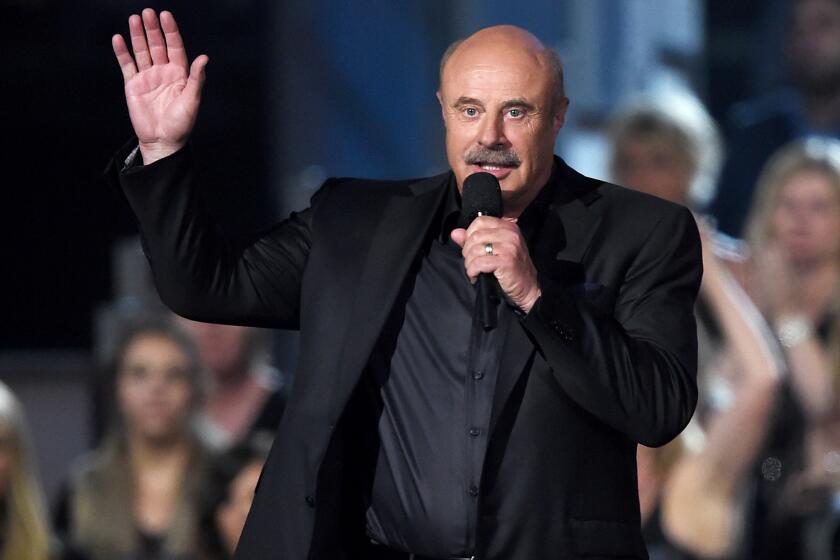Mastering Modernism : White Oak Troupe Toys With the Rules
- Share via
ESCONDIDO — Silence is always news in American dance, if only because so much classical and contemporary choreography in our aging century has focused on music visualization. Formed by the supremely musical Mikhail Baryshnikov and the often subversively musical Mark Morris, the White Oak Dance Project pretty much played by the rules in its first five years and now, in year six, is touring a program of solos danced to Bach, Scarlatti and Shostakovich--part of the time.
The rest of the time, however, silence reigns. Specifically, Dana Reitz and Baryshnikov each venture unaccompanied 20-minute solos choreographed by Reitz in the mercurial, nonlinear, postmodern style that earned her an enthusiastic international following during the same period when Baryshnikov first dazzled and then dominated American ballet.
Both solos prize what Reitz has called “the fluctuating dynamics of motion, thought and intuition,” emphasizing processes of change that are often defined by the lighting designer as much as the choreographer. Where music and dance are partners in other people’s work, lighting and dance form the essential relationship in Reitz’s.
In a sold-out performance at the 1,500-seat California Center for the Arts on Tuesday, “Private Collection” found Reitz repeatedly striding out of darkness into sequences of brightly illuminated activity: bold, swooping arm-driven motion, for the most part, with each stride-entrance beginning a new chapter of personal revelations. The components included realistic pantomime, intense dodging/fighting/teetering sequences in which she repelled some unseen adversary, and most memorable, perhaps, the moments when she threw her arms over her head as if too much in pain to even be seen.
“Unspoken Territory,” Reitz’s solo for Baryshnikov, also exploited contrasts between deliberately mundane gesture and heightened, engulfing expressivity. Here, however, the archaic body-sculpture and gauzy, layered Santo Loquasto tunic suggested ancient Assyrian or Hittite reliefs, while Baryshnikov often danced just outside the light, as if he didn’t belong in its warmth and was trying to circle it or (at one point) measure it.
Jennifer Tipton’s lighting not only provided atmosphere galore but set up the biggest joke: a moment when Baryshnikov flattened his hand into a shadow-puppet of a barking dog.
The pileup of juxtapositions soon became a little overwhelming: contemporary versus antique posture, high-velocity turns versus moments of staring offstage--even a “good evening” to the audience and a cough that broke the code of silence. One way to interpret it all: a character portrait intent on showing us the remarkable energy, determination, humor and bravery of Baryshnikov while evoking without explanation the mystery of his genius.
*
At 48, he remains a great dancer and also has become something of an evolutionary force, using his fame to attract mainstream dance audiences to works by the modernist innovators who otherwise would never be seen in the American culture palaces monopolized by ballet. On Tuesday, in addition to Reitz, those innovators included Morris and Jose Limon. From the former: “Three Russian Preludes” to Shostakovich, balletic in style with sunny, throwaway arms and eccentric gestural details lightening and varying the prevalent formalism.
From Limon: “Chaconne,” to a piano transcription of Bach, a 1942 playoff between noble, grand-scale poses and smaller, lighter, faster dancing that Baryshnikov, of course, rendered with effortless exactitude.
Reitz also danced her “Shoreline” solo to Scarlatti, a work of quicksilver moods in which small quivers--tiny hops in place--kept suggesting a trembling expectancy, as if she were watching or remembering something that stirred her deeply. In her shapeless, gray Barbara Matera dress with elbow-length sleeves, she could have been a little girl caught up in happy secrets or someone letting her arms drift in the wind to feel connected to something larger than herself. Reitz imposes no meanings but they open up, infinitely, the more you watch.
As usual, White Oak offered exemplary musicianship--in this case, pianist Nicolas Reveles. Michael Chybowski designed the lighting for “Three Russian Preludes” and Tipton for “Shoreline,” and David Finn for “Chaconne,” “Private Collection” and “Meeting Place,” Reitz’s brief breezy curtain call dance for her and Baryshnikov.
More to Read
The biggest entertainment stories
Get our big stories about Hollywood, film, television, music, arts, culture and more right in your inbox as soon as they publish.
You may occasionally receive promotional content from the Los Angeles Times.










